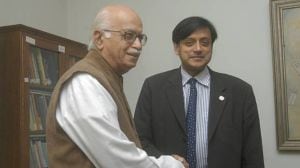Stay updated with the latest - Click here to follow us on Instagram
Pillar to the past
Delhi's ancient connections are all but lost--ravaged by time and conquests or rebuilt and renovated in a manner that has wiped out the relics completely.
The Ashokan rock edict near East of Kailash,the citys link to its Mauryan past,gets a facelift
Delhi’s ancient connections are all but lost–ravaged by time and conquests or rebuilt and renovated in a manner that has wiped out the relics completely. So,it’s heartening to see that at least efforts have been made to beautify the environs of the city’s lone link to its Mauryan past.
Around eight to ten years ago,this mound between East of Kailash and Sreenivaspuri was nothing but a garbage dump and an open toilet for the nearby slums and shacks. Then,the ISCKON temple came up in the vicinity and with a Buddhist monastery already in the area,the Ashokan rock edict atop a small hillock on Raja Dhirsain Marg got its due,at least somewhat. An ugly concrete shelter with iron grills was built over the rock edict for its protection. Now,the hillock is amid a huge park,with stone pathways lined with shady trees,flowering plants and creepers. And as Omprakash,the enthusiastic Archaeological Survey of India employee,pointed out,there are also trees planted by visiting dignitaries the most recent one being a peepal planted by the Princess of Thailand.
A flight of stairs with a steel railing takes one to the rock edict and Omprakash is only too keen to open the iron gates so that the rare tourist visiting the park sees the centuries-old edict.
The city’s other two Ashokan edicts are on pillars,both of which were brought here by Feroz Shah Tughlaq in the 14th century one from Meerut and the other from Topra. The rock edict then is a Mauryan legacy Delhi can claim as its own. It was discovered only in the 1960s. Historians have classified it as a minor edict on an ancient trade route. The area was known as Bahapur and with the ancient Kalkaji temple at almost walking distance it was perhaps on a pilgrim route as well. In fact,there was also a Mughal Kos Minar nearby and so it was in all probability one of the main caravan routes during both ancient and medieval times.
In the edict,the king says that it’s been only two-and-a-half years since he became an upasaka or a devotee and how he was drawn towards the sangha or the Buddhist monastic order. Ashoka claims that due to his efforts,gods and men were mingling with each other in Jambudvipa (India) and that anyone rich or poor could attain heaven by following the dhamma. While urging people to follow the path of dhamma,the edict also proclaims that people living beyond the empire’s borders could also learn about it.
As one climbed down the stairs,one could hear the temple bells and noise from the adjacent car repair shops overlap. A monk from the nearby Buddhist centre led a group of Sri Lankan Buddhist monks towards the edict.
They are here for a fortnight and come here almost every day. But the place hardly sees any tourist otherwise, says Omprakash. Outside,vehicles line up on the road as tourists and devotees queue up to visit the ISCKON temple next door.







